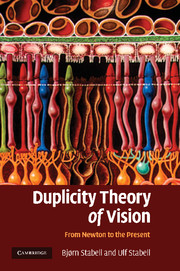Book contents
- Frontmatter
- Contents
- Acknowledgements
- 1 Introduction
- Part I The development of the basic ideas of the duplicity theory from Newton to G. E. Müller
- Part II The development of the duplicity theory from 1930–1966
- Part III Chromatic rod vision: a historical account
- 11 Night vision may appear bluish
- 12 Mechanisms of chromatic rod vision in scotopic illumination
- 13 Rod-cone interactions in mesopic vision
- 14 Further exploration of chromatic rod vision
- Part IV Theories of sensitivity regulation of the rod and cone systems: a historical account
- Part V Factors that triggered the paradigm shifts in the development of the duplicity theory
- References
- Index
11 - Night vision may appear bluish
Published online by Cambridge University Press: 22 January 2010
- Frontmatter
- Contents
- Acknowledgements
- 1 Introduction
- Part I The development of the basic ideas of the duplicity theory from Newton to G. E. Müller
- Part II The development of the duplicity theory from 1930–1966
- Part III Chromatic rod vision: a historical account
- 11 Night vision may appear bluish
- 12 Mechanisms of chromatic rod vision in scotopic illumination
- 13 Rod-cone interactions in mesopic vision
- 14 Further exploration of chromatic rod vision
- Part IV Theories of sensitivity regulation of the rod and cone systems: a historical account
- Part V Factors that triggered the paradigm shifts in the development of the duplicity theory
- References
- Index
Summary
The origin of the idea that rods may give rise to chromatic sensations may be traced back to the hypothesis of Ebbinghaus (1893) that the photopigment of rods (rhodopsin) was the yellow-blue see-substance postulated by Hering (1878), and the suggestion of König (1894) that the rod receptors represented the primary ‘blue’ receptor system of photopic vision. Substantial evidence in favour of the idea was provided by von Kries and Nagel (1896) who found that twilight vision contained a tint of blue.
In order to identify more precisely this blue colour quality of rods, von Kries (1896) attempted to find the spectral light that did not change its hue when test intensity was reduced from photopic to scotopic levels, i.e. when the rod component increased. He used Nagel (a deutranope) as his subject and instructed him first to make a colour match at a photopic intensity level between a homogeneous spectral test light from the short-wave region of the spectrum (and hence with a relatively high potential scotopic value) and a mixture of spectrum red (670 nm) and violet (435 nm) lights (and hence with a relatively low potential scotopic value). Thereafter, the intensity of the test and comparison fields was reduced in the same proportion from the photopic level until the homogeneous light strongly activated the rod component. His results showed that the spectral light that did not change in colour quality with intensity reduction was situated between 480–485 nm, i.e. in the green-blue part of the spectrum.
- Type
- Chapter
- Information
- Duplicity Theory of VisionFrom Newton to the Present, pp. 109 - 112Publisher: Cambridge University PressPrint publication year: 2009



